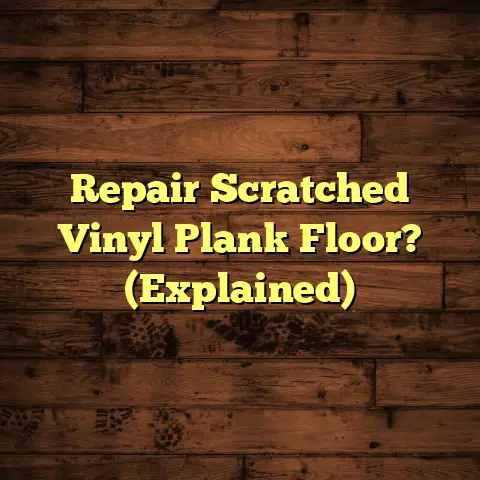Laminate Vs Vinyl With Dogs? (6 Things to Know)
After years of ripping up floors and installing new ones, I’ve seen it all – including the aftermath of happy, but sometimes destructive, pups.
Choosing the right flooring when you have dogs
is a HUGE deal.
It’s not just about aesthetics;
it’s about your sanity, your dog’s comfort,
and the long-term value of your home.
I can’t tell you how many times I’ve heard homeowners lament their flooring choices after their furry friends have wreaked havoc.
It impacts your pet’s quality of life.
It impacts your home’s maintenance.
It impacts the overall look of your place.
So, let’s dive into the age-old debate: Laminate vs. Vinyl for dog owners.
I’m going to break down six crucial things
you need to consider before making that big decision.
Ready?
Let’s get started!
1. Durability and Resistance to Scratches:
The Paw-Proof Test
Okay, let’s be real. Dogs and scratches go hand-in-hand, right?
Whether it’s zoomies across the living room or enthusiastic greetings at the door, your floors are bound to take a beating.
So, how do laminate and vinyl stack up when it comes to scratch resistance?
Laminate flooring typically consists of a high-density fiberboard (HDF) core, topped with a photographic layer and a protective wear layer.
The wear layer is key here.
It’s usually made of aluminum oxide,
which provides decent scratch resistance.
However, not all laminates are created equal.
The thicker the wear layer, the better
it will hold up against dog claws.
Look for an AC (Abrasion Class) rating of
AC3 or higher for good scratch resistance.
AC4 or AC5 is even better for high-traffic areas
and larger, more active dogs.
Vinyl flooring, on the other hand,
is typically made of multiple layers of PVC
and other materials.
It comes in various forms,
including sheet vinyl, vinyl tiles,
and luxury vinyl planks (LVP).
LVP is a popular choice because it mimics the look of hardwood or stone while offering superior durability and water resistance.
The wear layer on vinyl flooring is measured in mils
(thousandths of an inch).
A thicker wear layer means better protection
against scratches and scuffs.
For dogs, I recommend a wear layer of
at least 20 mils.
Anything less, and you might start seeing
scratch marks sooner than you’d like.
So, which one wins the scratch-resistance battle?
In my experience, high-quality vinyl flooring with a thick wear layer generally outperforms laminate when it comes to resisting scratches from dog claws.
While laminate can be scratch-resistant, it’s more prone to surface scratches that can become noticeable over time.
Vinyl, especially LVP, tends to be more forgiving and can better withstand the daily wear and tear inflicted by our furry friends.
I’ve seen countless laminate floors scratched by even small dogs, whereas quality vinyl holds up great.
2. Water Resistance and Maintenance Requirements:
The Oops-Proof Factor
Let’s face it: accidents happen.
Whether it’s a spilled water bowl,
a muddy paw print, or, well,
something else entirely, your floors
are going to encounter moisture.
So, how do laminate and vinyl handle water, and what kind of maintenance is required to keep them looking their best?
Laminate flooring is not naturally waterproof.
The HDF core is highly susceptible to water damage.
If water seeps into the seams or through the surface,
it can cause the core to swell, warp, and eventually
ruin the floor.
Some laminates are marketed as “water-resistant,” but that usually means they can withstand small spills for a limited time.
It’s crucial to clean up spills immediately to prevent water from penetrating the surface.
Vinyl flooring, on the other hand, is inherently waterproof.
It doesn’t absorb water, making it an excellent choice
for areas prone to spills and moisture, like kitchens,
bathrooms, and, yes, homes with dogs.
LVP, in particular, is a great option because the planks are designed to click together tightly, creating a water-resistant seal.
Even if water sits on the surface for an extended period, it’s unlikely to cause any damage.
Maintenance-wise, both laminate and vinyl are relatively easy to clean.
For laminate, I recommend sweeping or vacuuming
regularly to remove dirt and debris.
When mopping, use a damp mop and a cleaner
specifically designed for laminate floors.
Avoid using excessive water, as it can seep into the seams.
For vinyl, you can sweep, vacuum, or mop as needed.
Use a mild detergent and water to clean up spills
and messes.
Vinyl is more forgiving than laminate,
so you don’t have to be as careful with moisture.
The verdict on water resistance?
Vinyl is the clear winner. Its waterproof properties make it a much better choice for dog owners who want peace of mind knowing that their floors can withstand spills and accidents.
Laminate can work if you’re diligent about cleaning up spills immediately, but it’s not as worry-free as vinyl.
I’ve seen laminate floors ruined by a single overturned water bowl, while vinyl floors have shrugged off much worse without any damage.
3. Comfort and Traction for Pets:
The Paw-Friendly Factor
Okay, we’ve talked about durability and water resistance, but what about your dog’s comfort?
After all, they’re the ones who will be spending the most time on the floor.
Laminate flooring tends to be harder and colder
than vinyl.
It can be uncomfortable for dogs to lie on
for extended periods, especially in colder climates.
It can also be slippery, especially for dogs with long nails or those who are prone to slipping.
Vinyl flooring, on the other hand, tends to be softer and warmer underfoot.
It provides better cushioning and traction, making it more comfortable for dogs to walk, run, and play on.
Some vinyl flooring options even have textured surfaces that further enhance traction.
This is especially important for older dogs or those with joint problems, as it can help prevent slips and falls.
In my experience, dogs generally prefer vinyl over laminate.
I’ve seen dogs actively avoid walking on laminate floors, opting instead to stick to rugs or carpeted areas.
They seem to appreciate the softer, warmer feel of vinyl.
So, which one is more comfortable for your furry friend?
Vinyl, hands down. It provides better cushioning, traction, and warmth, making it a more comfortable and safer choice for dogs.
If you do choose laminate, consider adding rugs or mats in high-traffic areas to provide your dog with a more comfortable surface to walk on.
4. Aesthetic Appeal and Variety:
The Style Factor
Let’s not forget about aesthetics!
Your floors should not only be durable and
comfortable for your dog but also complement
your home’s style.
Laminate flooring comes in a wide variety
of styles, colors, and patterns.
It can mimic the look of hardwood, stone,
or tile, allowing you to achieve the desired look
without the high cost and maintenance.
However, some laminate floors can look artificial or cheap, especially those with repetitive patterns or unrealistic textures.
Vinyl flooring has come a long way in recent years.
Modern LVP can convincingly replicate
the look of natural materials, with realistic
textures and patterns.
It’s also available in a wide range of colors and styles, from traditional wood-look planks to contemporary stone-look tiles.
One of the advantages of vinyl is that it can be printed with virtually any design, allowing for greater customization and creativity.
In terms of aesthetic appeal, it really comes down to personal preference.
Some people prefer the classic look of hardwood, which can be closely replicated with high-quality laminate or vinyl.
Others prefer the modern, sleek look of tile or stone, which can also be achieved with vinyl flooring.
I’ve seen both laminate and vinyl floors that look absolutely stunning.
The key is to choose a product that complements your home’s style and your personal taste.
So, which one wins the style battle?
It’s a tie! Both laminate and vinyl offer a wide range of aesthetic options, allowing you to create the perfect look for your home.
Just be sure to choose a high-quality product with a realistic texture and pattern to avoid that artificial look.
5. Cost and Value Over Time:
The Budget Factor
Of course, cost is always a major consideration when choosing flooring.
Let’s break down the cost of laminate and vinyl flooring, both in terms of initial investment and long-term value.
Laminate flooring is generally less expensive than vinyl flooring upfront.
The average cost of laminate flooring ranges from \$2 to \$5 per square foot, including installation.
Vinyl flooring, particularly LVP, tends to be more expensive.
The average cost of LVP ranges from \$3 to \$7 per square foot, including installation.
However, the initial cost is only part of the equation.
You also need to consider the long-term value
of the flooring, including its durability,
maintenance requirements, and lifespan.
As we’ve already discussed, vinyl flooring is generally more durable and water-resistant than laminate flooring.
This means it’s less likely to be damaged by scratches, spills, or moisture, which can save you money on repairs and replacements in the long run.
Vinyl flooring also requires less maintenance than laminate flooring, which can save you time and money on cleaning and upkeep.
In terms of lifespan, both laminate and vinyl flooring can last for many years with proper care.
However, vinyl flooring tends to have a longer lifespan than laminate flooring, especially in high-traffic areas and homes with dogs.
So, which one offers the best value over time?
It depends. Laminate is cheaper upfront but has a higher chance of needing replacing sooner.
If you’re on a tight budget, laminate might be the more appealing option initially.
However, if you’re willing to invest a bit more upfront, vinyl flooring can offer better long-term value due to its superior durability, water resistance, and lifespan.
I’ve seen homeowners save thousands of dollars over the years by choosing vinyl flooring over laminate, simply because it held up better to their dogs and their active lifestyles.
6. Environmental and Health Considerations:
The Eco-Friendly Factor
Finally, let’s talk about environmental and health considerations.
It’s important to choose flooring that’s not only durable and comfortable but also safe for your family and the environment.
Laminate flooring is typically made from wood products, which can be a renewable resource.
However, some laminate floors contain formaldehyde, a volatile organic compound (VOC) that can be harmful to your health.
Look for laminate floors that are certified as low-VOC or formaldehyde-free.
Vinyl flooring is made from PVC, a synthetic plastic material.
PVC production can be harmful to the environment, and some vinyl floors contain phthalates, another type of VOC that can be harmful to your health.
However, there are now many eco-friendly vinyl flooring options available that are made from recycled materials and are free of phthalates and other harmful chemicals.
When choosing vinyl flooring, look for products that are certified by organizations like FloorScore or GreenGuard, which test for VOC emissions and ensure that the flooring meets strict environmental standards.
In terms of environmental impact, both laminate and vinyl flooring have their pros and cons.
Laminate is made from a renewable resource, but it can contain formaldehyde.
Vinyl is made from a synthetic material, but there are now many eco-friendly options available.
So, which one is better for the environment?
It’s a tough call. Look for certified low-VOC laminate.
When it comes to health considerations, it’s important to choose flooring that’s free of harmful chemicals and VOCs.
Look for products that are certified by organizations like FloorScore or GreenGuard to ensure that they meet strict environmental and health standards.
Conclusion: Making an Informed Decision
Okay, we’ve covered a lot of ground!
Choosing the right flooring for your home
when you have dogs is a big decision,
but I hope this guide has helped you
narrow down your options.
Remember to consider these six key factors:
- Durability and Scratch Resistance
- Water Resistance and Maintenance
- Comfort and Traction for Pets
- Aesthetic Appeal and Variety
- Cost and Value Over Time
- Environmental and Health Considerations
Ultimately, the best flooring for you will depend on your unique circumstances, lifestyle, and the needs of your furry friends.
If you prioritize durability, water resistance, and comfort, vinyl flooring (especially LVP) is an excellent choice.
If you’re on a tight budget and are willing to be diligent about cleaning up spills, laminate flooring can be a viable option.
No matter what you choose, be sure to do your research, read reviews, and talk to a flooring professional to ensure that you’re making the best decision for your home and your dogs.
And remember, a happy dog equals a happy home!
Good luck with your flooring project, and I hope you and your furry friends enjoy your new floors for many years to come!





